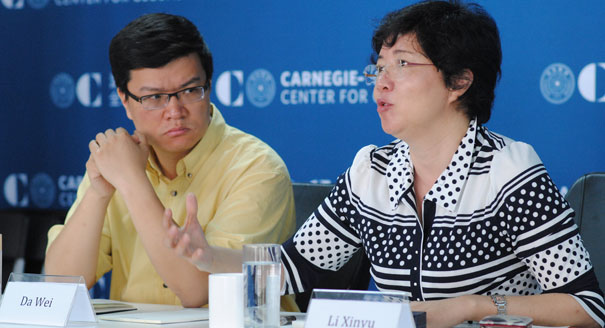Registration
You will receive an email confirming your registration.
City-to-city diplomacy is becoming an increasingly important exercise of U.S. and Chinese soft power, public diplomacy, and foreign policy strategies. This channel of exchange provides opportunities for more meaningful and beneficial interactions in the U.S.-China relationship while supporting the development of international metropolises in tandem with globalization and urbanization.
Carnegie–Tsinghua scholar Zhao Kejin hosted a panel featuring specialists in city-to-city relations, including Li Xinyu of the Chinese People’s Association for Friendship with Foreign Countries and Brian Hoyt of the U.S. embassy in Beijing. They discussed the promising effects of this form of diplomacy and how it can further strengthen the Sino-U.S. relationship.
Discussion Highlights
- More Flexible Diplomacy: Fostering local interactions builds trust, which is critical for the bilateral relationship, panelists said. They agreed that people-driven city-to-city diplomacy is more stable and flexible than high-level political or economic forms of diplomacy. It creates cultural exchange opportunities, such as linking universities with foreign scholars, burgeoning markets with investors, and common industries with chances for information and technology transfers. Statistically, city-to-city partnerships are the most robust and common form of U.S-China cooperation, they added.
- Rethinking Logical Partnerships: Panelists discussed the swift bloom of city partnerships across the Pacific since China’s opening-up period, ranging from “sister cities” to “friendship cities.” While some have resulted in real-world benefits, such as Portland’s partnership with Kunming to share clean technology and green development strategies, other partnerships have stagnated. Panelists agreed that these partnerships need to be reviewed for their potential to attract new cross-cultural initiatives and investment.
- Different Power Structures: Due to divergent governmental structures, local and municipal governing bodies in the United States and China differ in their respective political power, financial resources, and capabilities. The focus of these city-to-city partnerships is unclear and confusing, as China emphasizes economic linkages while the United States has many different objectives for its city partnerships, panelists said. They also noted the role of private enterprises, NGOs, and transnational networks in strengthening public diplomacy, social movements, and international relations.
- Recommendations: After the initial handshakes are over, panelists argued, city-to-city partnerships require proactive approaches and creative thinking to become successful exercises of diplomacy. Several panelists proposed that further institutionalization may be helpful in aligning the aims of partnered cities and facilitating their interactions, such as London’s office in Beijing that was opened in 2006 to promote exchanges of commerce, trade, and tourism. Emphasizing common interests and lending a larger role to civil society groups will create more modes of cooperation, increasing the international stature and reach of cities in a globalized era, they concluded.
Discussants Included: Da Wei, Diao Daming, Yu Wanli
